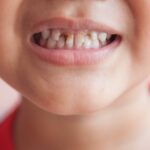
Baby Tooth Extrations Near Hurst, TX
Pediatric Tooth Extractions in Hurst, TX
What Is a Tooth Extraction?
A tooth extraction is a procedure in which a tooth is surgically removed. The procedure is generally very quick. In fact, usually, the majority of a child’s tooth extraction appointment consists of walking the patient (and parent) through the procedure, numbing the area around the tooth, and making sure the child is comfortable. The extraction itself typically only takes about a minute.
Most primary tooth extractions can be performed with local anesthesia alone, or with a combination of local anesthesia and nitrous oxide (“laughing gas”).
When Should a Child Have Teeth Removed?
Common reasons for tooth extractions in children include infection, crowding issues, and failure of baby teeth to fall out on their own.
Infection
Beneath the hard outer layer of a tooth lies a soft, gelatinous substance called “dental pulp.” Deep cavities and dental trauma can damage a child’s dental pulp and lead to infection, resulting in tooth pain, tooth sensitivity, redness and/or swelling. If the infection is not treated, it can spread beyond the tooth, potentially resulting in life-threatening conditions.
In some circumstances, infected dental pulp in a primary tooth can be treated using pediatric pulp therapy, and the tooth can be saved. Often, however, a severely infected primary tooth requires extraction.
Crowding Issues
When primary (“baby”) teeth are crowded together, they can sometimes prevent permanent teeth from coming in correctly. For example, sometimes two baby teeth are crowded into the space that a single permanent tooth will need once it comes in. If a child naturally loses one of those baby teeth, but the replacement permanent tooth cannot erupt properly because the other baby tooth is in the way, that second baby tooth may need to be extracted.
Permanent teeth can also present crowding issues and require removal. Sometimes a child’s jaw simply is not large enough to accommodate all of his or her permanent teeth. When this happens, one or more permanent teeth may be removed for orthodontic purposes.
Failure of Baby Teeth to Fall Out
Sometimes, a child’s permanent tooth will grow in behind the primary tooth it is replacing, rather than pushing up from under the primary tooth. Occasionally, this will prevent the primary tooth from becoming loose and falling out on its own.
Preparing Your Child for Baby Tooth Removal
Although the procedure is generally very quick and simple, many children feel nervous or anxious about having a tooth removed. As a board-certified pediatric dentist, Dr. Lin has been specially trained to help children understand the tooth extraction procedure and to put their fears to rest.
Before removing teeth, Dr. Lin will explain the procedure to your child using age-appropriate language and answer any questions you or your child might have. Many pediatric patients fear the needle used to apply the numbing agent more than they fear the tooth extraction itself. Dr. Lin is experienced at calming children’s fears about the application of local anesthesia and applying the numbing agent quickly and painlessly.
As a parent, you can help your child’s tooth extraction appointment go smoothly by preparing your child in advance. Before the appointment, sit down with your child to explain what will happen at the dentist. Children take cues from their parents, so explaining the procedure to your child in a calm, positive way can have a considerable impact on how your child will respond to the treatment.
Get in Touch to Schedule an Appointment for Pediatric Extractions
Hurst Pediatric Dentistry offers dental care to pediatric patients in Hurst, Texas, and nearby areas, including Colleyville, Euless, Bedford, Fort Worth, North Richland Hills, Keller and Southlake.
We take a compassionate, caring approach to dental care, and we take great pride in helping our patients feel comfortable and at home in our office. We offer emergency dental care as well as restorative and preventive dental services.
Get in touch today to book an appointment by calling the office at (817) 510-6400.




